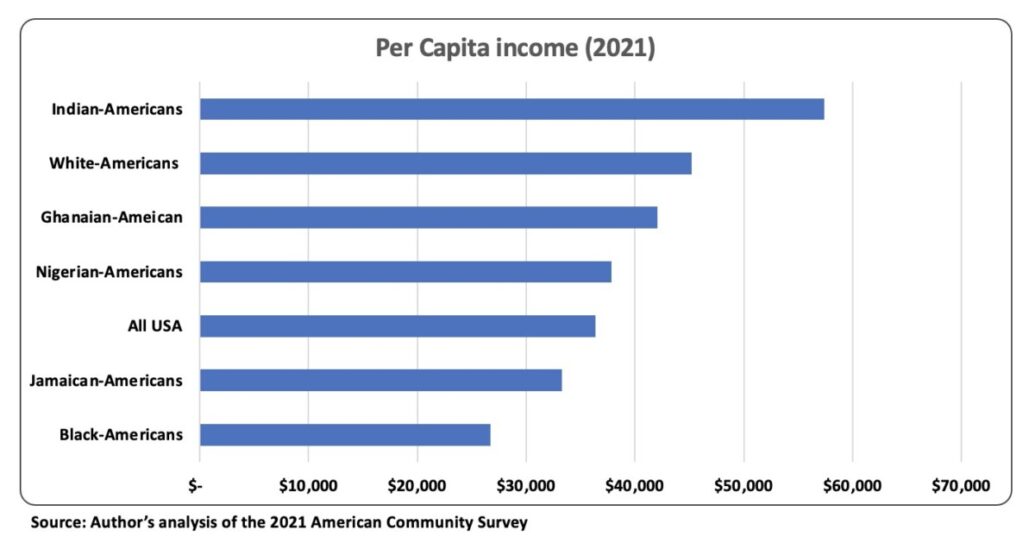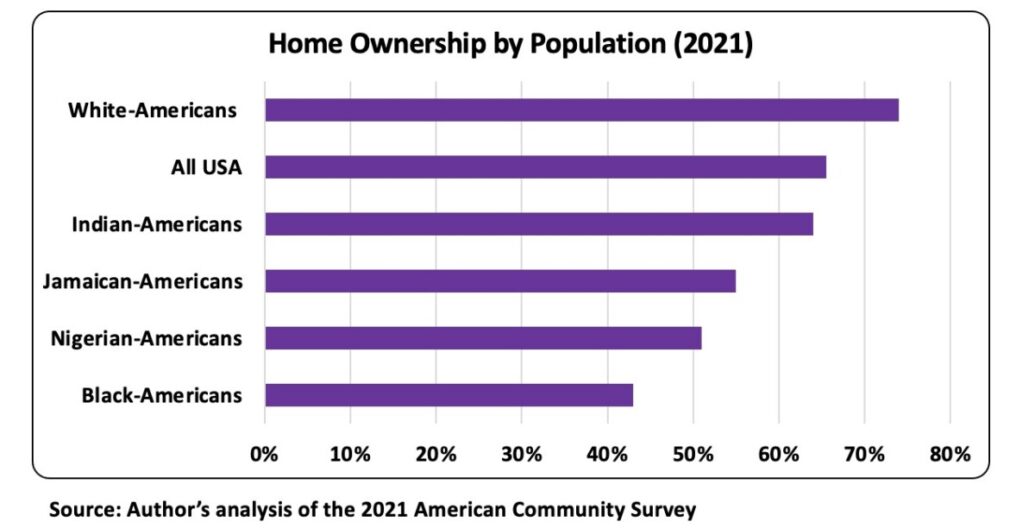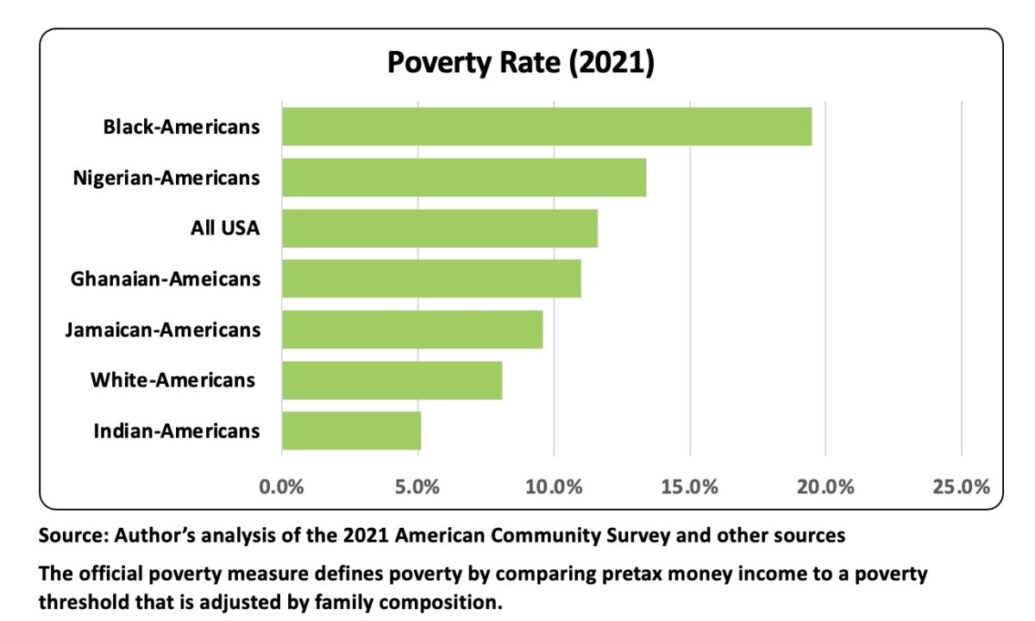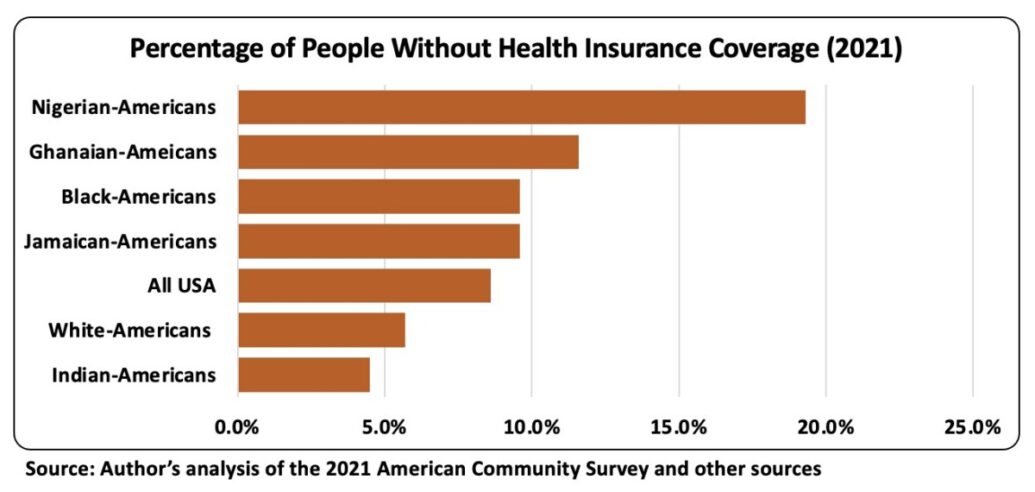By Nnaoke Ufere, PhD
In the United States, significant disparities exist in the success achieved by different immigrant groups. These differences are evident across various indicators, including educational attainment, representation in executive leadership positions, income levels, poverty rates, homeownership, health insurance coverage, and numerous other factors.
It is crucial to gain insights into the factors that underpin these differences. To address misconceptions and misunderstandings surrounding success factors within the Nigerian-American community, this report utilizes data from the US Census American Community Survey (ACS) to analyze and compare the achievements and challenges faced by Nigerian-Americans and Indian-Americans.
By addressing misconceptions and misunderstandings about success factors within the Nigerian-American community, this study contributes to a more nuanced understanding of immigrant group disparities.
This report provides insights that can inform collective and individual actions and initiatives aimed at promoting the success, upward mobility and well-being of Nigerian-Americans in the United States.
It also seeks to challenge and reshape perceptions of Nigeria and highlight the positive impact of Nigerian-Americans.
Now, let’s delve into the main findings that have emerged from my descriptive analysis of the American Community Survey (ACS) datasets from 2021 and literature review.
- The Nigerian-American population in 2021 consists of 530,661 individuals, with approximately 55% being migrants from Nigeria and other countries and 45% being born in the USA.
- Among the Nigerian-American population, 74.3% are US citizens, while 25.7% are non-US citizens. The citizenship rate among Nigerian immigrants is higher compared to other immigrant groups. An estimated 36,000 non-US citizens are undocumented Nigerians who have overstayed their visas.
- In 2021, 69% of Nigerian-American households were married couple households, while Indian-American households had a higher percentage of 94% and White-American (non-Hispanic) households had a slightly higher percentage of 76%. Around 10.7% of Nigerian-Americans are divorced or separated compared to less than 4% among Indian-Americans.
- The Nigerian-American population has experienced significant growth since the 1980s and is projected to surpass one million before 2030.

- In 2021, Nigerian-Americans ranked among the most highly educated racial or ethnic groups in the United States. Among them, 63% held college degrees and 19% held postgraduate degrees, exceeding the overall US population rates of 39% and 14% respectively. However, Indian-Americans had even higher educational attainment rates, with 76% holding college degrees and 43% holding postgraduate degrees.
- The median annual household income for Nigerian-Americans was $72,577, slightly below that of White (non-Hispanic) Americans ($74,932), but higher than that of Black Americans ($46,774) and the overall US household income ($67,717). However, Indian-Americans had a higher household income of $134,134.

- In terms of per capita income, Nigerian-Americans earned $36,333, which was lower than that of White (non-Hispanic) Americans ($45,175) and Indian-Americans ($57,398). However, it was higher than the per capita income of Black Americans ($26,725) and the overall US population ($37,838). The Nigerian-American population numbered 530,661 individuals, while the Indian-American population reached 4.4 million.

- In 2021, 35% of Nigerian-American households earned less than $50,000, while 51% earned less than $75,000. Importantly, 10.3% of Nigerian-American households earned $200,000 or more. However, 25% of Indian-Americans households earned $200,000 or more. Indian-Americans hold a significant share of jobs in several high-paying fields, including computer science, technology, strategy consulting, entrepreneurship, financial management and medicine.

- Nigerian-Americans have a diverse range of income levels and were overrepresented in lower-paying sectors/occupations such as government employees, cab drivers, and healthcare workers (e.g., nursing home aid workers, nurse assistants, etc.), while being underrepresented in higher-wage professional careers.
- A significant proportion of Nigerian-Americans, particularly those aged 65 and over, continue to work compared to the general US population. In 2021, 63.9% of Nigerian-Americans aged 65 and over were still working, with 36% of those aged 70 and over still in the workforce. Fewer than 12% of Indian-Americans 70 years and over were still in the workforce in 2021.
- Homeownership in America is a significant wealth-building factor. Regrettably, only 51% of Nigerian-Americans own their homes, which is lower than the rates of 74% among White-Americans (non-Hispanic), 64.2% among Indian-Americans, and 65.5% among the general USA population. Black-Americans have the lowest homeownership rate at 43%. Surprisingly, despite their high median income, a majority of Nigerians (49%) are renters.

- The median value of homes owned by Nigerian-Americans was $290,800 in 2021, which is lower than the median value of $485,200 for Indian-Americans. This disparity has significant impact on wealth-building between the two communities, all things being equal.
- Despite overall prosperity, 13.4% of adult Nigerian-Americans lived in poverty in 2021, compared to 5.1% of Indian-Americans and 11.6% of the entire US population.

- In 2021, 19.3% of Nigerian-Americans did not have health insurance at any point during the year, compared to 4.5% of Indian-Americans, 5.7% of White-Americans and 8.6% of the general US population. Lack of health insurance poses a significant risk to the health and well-being of Nigerian-Americans.

- The mean retirement income for retired Nigerian-Americans in 2021 was $22,081, lower than the $34,894 for Indian-Americans and the general US retirement income of $27,218. The mean Social Security income for Nigerian-Americans was $16,957, also lower than the $22,427 for Indian-Americans and the general US mean social security income of $21,296.
Without doubt, Nigerian-Americans have achieved remarkable success in the United States given their population size. They are highly educated and have substantial incomes.
However, there are still unanswered questions, paradoxes, and misconceptions within the Nigerian community that need clarification when analyzing the provided statistics.
To gain a clearer perspective, this article focuses on comparing Nigerian and Indian immigrants to address key questions and shed light on the existing paradoxes. When necessary, relative measures such as percentages and ratios are utilized to account for the differing population sizes between the two communities.
It is important to note that some questions and paradoxes may require further research for a comprehensive explanation.
QUESTIONS, PARADOXES AND MISCONCEPTIONS
First, let’s explore the reasons behind the disparities in median household income between Nigerian-Americans and Indian-Americans with comparable qualifications and English proficiency levels.
Nigerian-Americans have a median household income of $72,577 ($36,333 per capita), whereas Indian-Americans earn $134,134 ($57,398 per capita). The per capita income considers the disparity in population size between Nigerian and Indian immigrants in the United States.
The disparity in household income between Nigerian-Americans and Indian-Americans with similar qualifications and English proficiency can be attributed to multiple factors.
Underrepresentation in the High-Tech Sector: The high-tech sector, a significant driver of economic growth in the US, has seen limited representation of Nigerian-Americans. While there has been a small increase in the number of Nigerian-American computer science graduates entering the field, their representation remains limited.
In executive positions of high-tech companies, Nigerian-Americans make up less than 0.1%, while Indian-Americans account for over 25%. Additionally, when combining executive and managerial positions, Nigerian-Americans represent less than 1% at leading Silicon Valley firms, as reported by the Diversity in High Tech report by the US Equal Employment Opportunity Commission (EEOC).
Underemployment: Underemployment is a contributing factor to lower earnings among highly skilled Nigerian immigrants. Research indicates that newly arrived Nigerian-Americans are often overrepresented in low-paying sectors and occupations, such as government employees and roles like cab drivers, homecare or nursing home aid workers, nurse assistants, and delivery drivers, where Nigerian-Americans have a dominant presence compared to Indian-Americans.
Conversely, Nigerian-Americans are underrepresented in higher-wage professional careers, including top corporate executive positions, investment banking, strategy consulting, medical specialties, and innovation-driven entrepreneurship, where Indian-Americans are predominant.
However, the influx of Nigerian healthcare professionals, including doctors and nurses, in recent years is expected to positively impact the income levels of Nigerian-Americans in the future.
Diminishing Returns of Late-stage PhDs: Nigerian immigrants’ pursuit of PhD and medical degrees may lead them away from lucrative professional fields and careers such as software engineering, entrepreneurship, high technology, top business management, and strategy consulting.
Many Nigerian immigrants enrolled in PhD programs in the USA are older, surpassing their most productive academic years. Consequently, this delays their entry into the job market and increases their student loan burdens.
As a result, they may experience underemployment and receive lower compensation compared to individuals with engineering, law or MBA degrees from prestigious programs, which offer greater long-term earning potential. It is important to consider that the appeal of attaining long-running PhD and medical degrees may not yield the highest return on investment when compared to other professions.
Second, let’s examine the disparity in upward mobility in corporate America between Nigerian-Americans and Indian-Americans with comparable qualification and levels of proficiency in English. Why are there more Indian-American CEOs than Nigeria-American CEOs?
The disparity in upward mobility in corporate America between Nigerian-Americans and Indian-Americans with similar qualifications and English proficiency can be attributed to multiple factors.
Domain Expertise and Personal Characteristics: Indian-Americans have a dominant presence in the upper levels of leadership in renowned companies, particularly in the United States. A significant percentage, 73%, of Indian-Americans are employed in top professional and technology jobs, and many hold CEO positions in major US firms such as Microsoft, Alphabet, IBM, Adobe, Palo Alto Networks, VMWare, and Vimeo.
Their strong representation in fields like science, engineering, and management, along with their long tenures and a unique sense of humility and guile, sets them apart. HR experts interviewed for this article suggest that Nigerian-Americans may face challenges related to perceived impatience, a lack of diplomatic finesse, and a tendency to change jobs frequently, which can hinder their ability to establish long-term roots and hinder promotion opportunities.
Indian-Americans may have established strong networks that facilitate access to leadership positions and other opportunities, while Nigerian-Americans might face challenges in this regard.
Educational Attainment: Indian-Americans tend to have higher educational attainment levels, with a larger percentage of college graduates compared to Nigerian-Americans. Educational qualifications often play a significant role in career advancement.
Occupational Choices: Career choices and industries pursued can contribute to variations in leadership opportunities. Indian-Americans are often well-represented, given their large population, in fields such as technology, engineering, and entrepreneurship, which can offer higher leadership roles.
Racism and Career Advancement: On the other hand, racism may play a role in the underrepresentation of Nigerian-Americans in top corporate positions. Many Nigerian-Americans have highlighted the lack of mentorship, advocacy, and necessary coaching for their success.
However, it is important to note that Indian-Americans of various ethnic backgrounds, including Black Indians and Jamaican-Americans, have achieved success in corporate America, indicating that race alone may not be the sole determining factor.
It’s important to note that these factors are not exhaustive, and individual experiences and circumstances vary widely within each group.
Third, let’s assess the wide disparity in homeownership between Nigerian-Americans and Indian-Americans with comparable qualifications.
Homeownership rates are lower among Nigerian-Americans at 51% compared to 64.2% among Indian-Americans. This wide disparity in homeownership can be attributed to several factors.
Perception of America: One factor is the difference in values and priorities. Indian-Americans often perceive America as their “home” country and prioritize personal investments in America over India. They have a mindset of rootedness in America and build their homes and retirement plans there.
In contrast, many Nigerian immigrants consider Nigeria as their only “home” country, while America is seen as a “host” country, a place for work and income, essentially a transactional relationship. As a result, Nigerian immigrants may allocate their income to building grand homes in Nigeria, while renting accommodation in the US and facing challenges in affording homeownership.
Level of integration: A significant segment of Nigerian immigrants, particularly the first generation, have limited integration into the economic and social systems of their host country. Their primary focus is often on earning income to support retirement plans and projects back in Nigeria, the home country. In contrast, Indian-Americans typically retire within America and invest in building their retirement homes in the United States.
Affordability of Down Payment: As noted earlier, disparities in income, savings, credit worthiness and wealth-building between the two communities may also contribute to the homeownership disparity. Nigerian-Americans may face challenges in saving for down payment for a home, typically 20% of home sales price, due to lower income and lack of savings compared to Indian-Americans.
Also, maintaining homes in Nigeria requires ongoing expenses and annual trips, leading to significant financial burdens. These expenses include furnishing, maintenance, replacements, fumigation, security guards, high airfare costs, lost wages, vehicle expenses, home maintenance, gifts, and security expenses. This transnational dualism and the accumulation of expenses can strain their income and financial resources, making it difficult for them to afford down payment for homeownership in the US.
Forth, let’s examine why highly compensated Nigerian-Americans often continue working well into their 70s, while their Indian-American and other immigrant groups (e.g., Jamaican-Americans) of the same age group can afford to retire at the age of 65?
Retirement Investing: The ability of Indian-Americans and other immigrant groups to retire at the age of 65 can be attributed to their high savings rates and utilization of retirement savings opportunities, such as employer-provided plans and individual savings options.
This enables them to secure financial stability for retirement. However, many highly compensated Nigerian-Americans continue working into their 70s due to lower participation in retirement savings accounts, limited investments in the stock market, and insufficient savings for retirement.
In 2021, the retirement income for retired Nigerian-Americans was $22,081, which is lower than the $34,894 observed among Indian-Americans. This indicates that Nigerian-Americans often have to work beyond the traditional retirement age to meet their financial needs in old age.
Social Security Income: The average Social Security income for Nigerian-Americans stood at $16,957, which is lower than the $22,427 received by Indian-Americans and the general US average of $21,296. This suggests that a majority of Nigerian-Americans who are ineligible for social security and have not saved enough for retirement must continue working into their old age.
Finally, let’s explore the disparity in poverty rates between Nigerian-American and Indian-Americans.
Low Income: Nigerian-Americans have a poverty rate of 13.4%, whereas Indian-Americans have a poverty rate of only 5.1%. The higher poverty rates observed among Nigerian-American households, despite their higher median income compared to other immigrant groups like Indian-Americans, can be attributed to two key factors.
Firstly, first-generation Nigerians often face underemployment and earn lower incomes compared to first-generation Indian-Americans. This limited income, coupled with larger family sizes, makes it challenging to stretch their earnings and save adequately. As they age, some Nigerian-Americans who are ineligible for social security income rely on welfare checks and food stamps for support.
Secondly, spending habits, including living beyond one’s means, can contribute to financial instability and a higher likelihood of falling into poverty.
MISCONCEPTIONS
Are Nigerian-Americans the most educated and successful immigrants in the USA?
There is a prevailing notion in Nigerian media and among Nigerian-Americans that portrays them as the “most successful immigrant group in the US.” However, when evaluating success based on various indicators such as educational attainment, representation in top executive positions, income levels, homeownership rates, health insurance coverage, divorce rates, and criminal arrests, Nigerian-Americans do not hold the title of the most successful group, nor do they come close to achieving that distinction.
While Nigerian-Americans do exhibit a higher level of education compared to the general US population, it is important to recognize that other immigrant groups, such as Indian-Americans, surpass them in terms of educational attainment, particularly when measured by the percentage of college graduates aged 25 and older. Among Nigerian-Americans, 63% hold college degrees, whereas the corresponding figure for Indian-Americans stands at 76%.
However, the second generation of Nigerian-Americans has displayed potential and determination in competing with other groups and achieving success in America. Unlike their parents, they have diversified their educational fields and pursued careers beyond the confines of the “PhD and medicine or bust” mindset prevalent in the previous generation.
CONCLUSION
The challenges faced by Nigerian-Americans, including earnings, homeownership, representation in executive positions, and underemployment of highly skilled individuals, highlight the need for further examination. Addressing these issues can promote upward mobility and success for Nigerian-Americans while reshaping perceptions of our home country, Nigeria.
As the Nigerian-American community continues to expand, its economic, political, and social influence will also grow. However, effectively harnessing this influence requires careful consideration. One crucial aspect is unity and strength in numbers.
Establishing a well-organized national organization that shares a vision and strategy for achieving economic and political progress, while recognizing the contributions of Nigerian-Americans in the United States, similar to the accomplishments of Indian-Americans, is essential.





